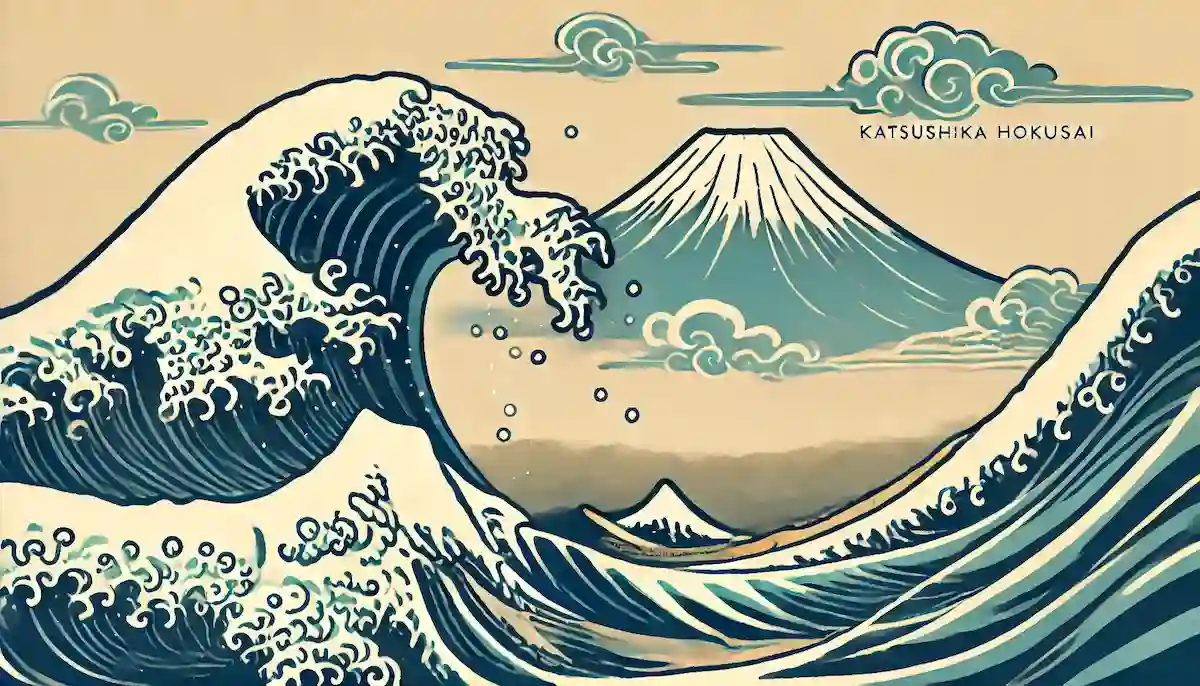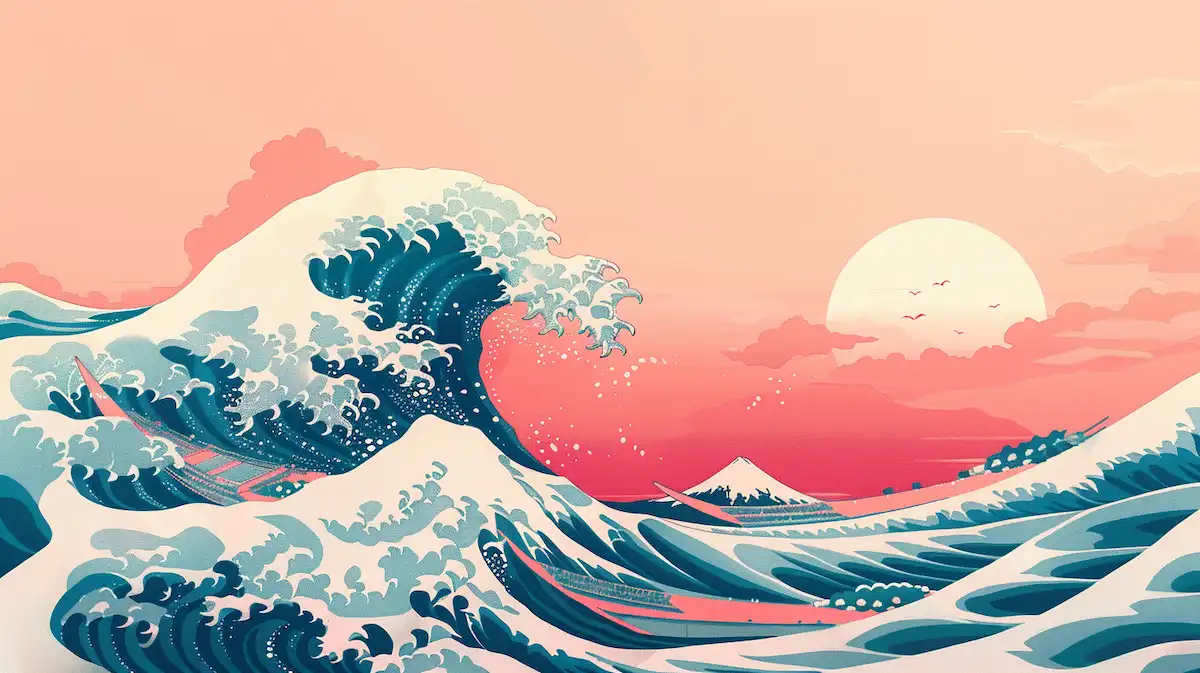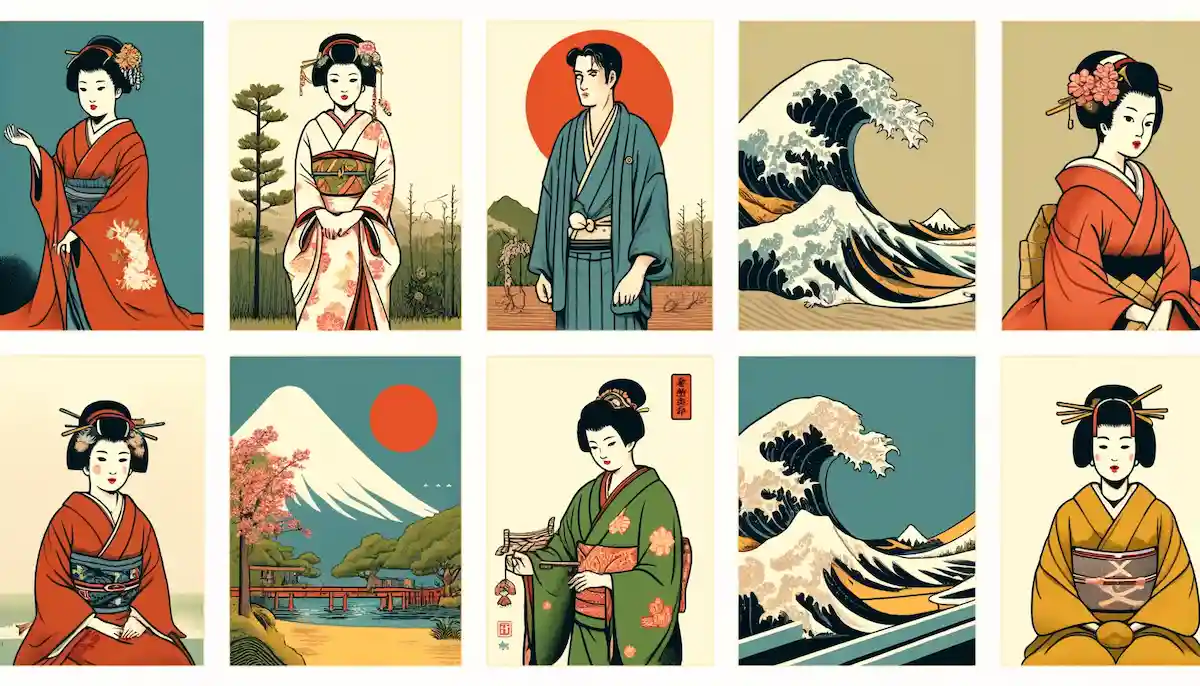浮世絵を英語で説明・紹介するための基本情報と、英会話に役立つ表現をシンプルでわかりやすい英語で紹介します。
英会話ダイアローグ・関連情報・10の質問を通して、浮世絵に関する英語表現を学びます。
英語
英会話ダイアローグを読む前に知っておくと良い前提知識と情報は以下の通りです。
- 浮世絵の基本情報
- 浮世絵の定義: 浮世絵は、17世紀から19世紀にかけて日本で発展した絵画と版画のスタイル。「浮世の絵」という意味。
- 主な題材: 美人画、役者絵、風景画、日常生活の場面などが主な題材
- 技法: 木版画の技法を使用し、木の板に絵を彫り、インクをつけて紙に印刷。鮮やかな色と太い線が特徴
- 重要な人物と作品
- 菱川師宣: 最初の浮世絵を作成した人物
- 葛飾北斎: 代表作は「富嶽三十六景」
- 歌川広重: 代表作は「東海道五十三次」
- 浮世絵の影響
- ジャポニズム: 19世紀後半、ヨーロッパで浮世絵が大人気となり、西洋の芸術家に大きな影響を与えました。
- 影響を受けた画家: ヴィンセント・ヴァン・ゴッホやクロード・モネなど
- 東京の浮世絵美術館
- 太田記念美術館: 渋谷にある浮世絵専門の美術館
- すみだ北斎美術館: 墨田区にある葛飾北斎に焦点を当てた美術館
2人が浮世絵について話しています。
浮世絵の特徴、技法、歴史、著名な画家と作品、海外での人気、そして東京で浮世絵を鑑賞できる美術館について、話題にしています。
会話 / dialogue

Hey Key, I’ve been really interested in ukiyo-e lately. Do you know much about it?

Yeah, ukiyo-e is fascinating! It’s a Japanese art style from the 17th to 19th centuries. Have you seen any famous pieces?

I’ve heard of Hokusai’s “Thirty-Six Views of Mount Fuji.” It’s amazing how detailed and colorful they are.

Absolutely. Hokusai is one of the most famous ukiyo-e artists. Another well-known artist is Hiroshige. His “The Fifty-Three Stations of the Tōkaidō” series is also very popular.

What do these artworks usually depict?

Ukiyo-e often shows beautiful women, kabuki actors, landscapes, and daily life scenes. They use bold lines and bright colors. The technique involves woodblock printing, where they carve images into wood blocks, ink them, and then press them onto paper.

That sounds like a lot of work! Who started ukiyo-e?

The earliest ukiyo-e prints were made by Hishikawa Moronobu in the late 1600s. His work laid the foundation for this art form.

I heard that ukiyo-e was popular in Europe too. Is that true?

Yes, in the late 19th century, there was a trend called “Japonism” in Europe. Artists like Vincent van Gogh and Claude Monet were inspired by ukiyo-e. They integrated its elements into their own works.

That’s really interesting! Are there any good places to see ukiyo-e in Tokyo?

Definitely. You should visit the Ota Memorial Museum of Art in Shibuya. It specializes in ukiyo-e and has many exhibitions. There’s also the Sumida Hokusai Museum in Sumida, which focuses on Hokusai’s works.

Those sound like great places to start. Do they have any special exhibitions?

Yes, they often have themed exhibitions and events. It’s a good idea to check their websites before visiting.

I’m excited to go! By the way, why is it called “ukiyo-e”?

“Ukiyo-e” means “pictures of the floating world.” It reflects the idea of enjoying the present moment and the transient beauty of life.

That’s a beautiful concept. Thanks for the information, Key. I can’t wait to learn more and see these artworks in person.

You’re welcome, Mack. Enjoy your journey into the world of ukiyo-e!
関連情報 / related information
「浮世絵」について、理解を深めるための「英語での関連情報」です。
浮世絵

What is Ukiyo-e?
Ukiyo-e is a style of Japanese art that was popular from the 17th to 19th centuries. The term “ukiyo-e” means “pictures of the floating world.” This art often shows beautiful women, kabuki actors, landscapes, and scenes from everyday life.
Main Features
Ukiyo-e uses a special technique called woodblock printing. Artists carve pictures into wood blocks, ink them, and then press them onto paper. This method allows for bright colors and bold lines, making the images very vivid and detailed.
Famous Artists
There are several famous ukiyo-e artists. Katsushika Hokusai is well-known for his series “Thirty-Six Views of Mount Fuji,” which includes the famous print “The Great Wave off Kanagawa.” Another famous artist is Utagawa Hiroshige, who created the series “The Fifty-Three Stations of the Tōkaidō.” Hishikawa Moronobu is known for making the earliest ukiyo-e prints.
Influence in Europe
In the late 19th century, ukiyo-e became very popular in Europe. This trend was called “Japonism.” Many Western artists, like Vincent van Gogh and Claude Monet, were inspired by ukiyo-e and included its elements in their own works.
Where to See Ukiyo-e in Tokyo
If you want to see ukiyo-e in Tokyo, you can visit the Ota Memorial Museum of Art in Shibuya. This museum specializes in ukiyo-e. Another place is the Sumida Hokusai Museum in Sumida, which focuses on the works of Katsushika Hokusai.
10の質問 / 10 questions
「浮世絵」について、理解を深めるための「英語での10の質問」です。
1: What is ukiyo-e?
Ukiyo-e is a style of Japanese art that was popular from the 17th to the 19th centuries. It features woodblock prints and paintings that depict various subjects like landscapes, beautiful women, and kabuki actors.
2: Who are some famous ukiyo-e artists?
Some famous ukiyo-e artists include Katsushika Hokusai, known for "The Great Wave off Kanagawa," and Utagawa Hiroshige, famous for "The Fifty-Three Stations of the Tōkaidō."
3: What does ukiyo-e mean?
Ukiyo-e means "pictures of the floating world." It represents the transient and fleeting nature of life during the Edo period.
4: What are common subjects in ukiyo-e?
Common subjects in ukiyo-e include beautiful women (bijin-ga), kabuki actors, landscapes, and scenes from everyday life in Edo-period Japan.
5: How are ukiyo-e prints made?
Ukiyo-e prints are made using a woodblock printing technique. Artists carve images into wooden blocks, apply ink, and press them onto paper to create the final print.
6: What is "The Great Wave off Kanagawa"?
"The Great Wave off Kanagawa" is a famous ukiyo-e print by Katsushika Hokusai. It is part of his series "Thirty-Six Views of Mount Fuji" and depicts a large wave threatening boats.
7: Why did ukiyo-e become popular in Europe?
Ukiyo-e became popular in Europe in the late 19th century during the Japonism movement. Western artists were inspired by the style, and it influenced their works.
8: Where can you see ukiyo-e in Tokyo?
In Tokyo, you can see ukiyo-e at the Ota Memorial Museum of Art in Shibuya and the Sumida Hokusai Museum in Sumida. Both museums have extensive collections.
9: What is "The Fifty-Three Stations of the Tōkaidō"?
"The Fifty-Three Stations of the Tōkaidō" is a famous ukiyo-e series by Utagawa Hiroshige. It depicts the various stations along the Tōkaidō road, which connected Edo (Tokyo) to Kyoto.
10: How did ukiyo-e influence Western art?
Ukiyo-e influenced Western art during the late 19th century. Artists like Vincent van Gogh and Claude Monet admired the style and incorporated elements of it into their own paintings.
和訳付
会話 / dialogue

Hey Key, I’ve been really interested in ukiyo-e lately. Do you know much about it?
ねえ、キー。最近、浮世絵にすごく興味があるんだ。浮世絵について詳しい?

Yeah, ukiyo-e is fascinating! It’s a Japanese art style from the 17th to 19th centuries. Have you seen any famous pieces?
うん、浮世絵はとても魅力的だよ!17世紀から19世紀にかけての日本の美術様式なんだ。何か有名な作品を見たことある?

I’ve heard of Hokusai’s “Thirty-Six Views of Mount Fuji.” It’s amazing how detailed and colorful they are.
葛飾北斎の「富嶽三十六景」を聞いたことがあるよ。すごく詳細で色鮮やかだよね。

Absolutely. Hokusai is one of the most famous ukiyo-e artists. Another well-known artist is Hiroshige. His “The Fifty-Three Stations of the Tōkaidō” series is also very popular.
その通り。北斎は最も有名な浮世絵師の一人だね。もう一人有名なのは歌川広重で、彼の「東海道五十三次」シリーズもとても人気があるよ。

What do these artworks usually depict?
これらの作品は通常何を描いているの?

Ukiyo-e often shows beautiful women, kabuki actors, landscapes, and daily life scenes. They use bold lines and bright colors. The technique involves woodblock printing, where they carve images into wood blocks, ink them, and then press them onto paper.
浮世絵は、主に美人画、歌舞伎役者、風景、日常生活の場面を描いているよ。太い線と鮮やかな色を使っているんだ。技法としては木版画が使われていて、木の板に絵を彫って、インクをつけて紙に押し付けるんだ。

That sounds like a lot of work! Who started ukiyo-e?
それは大変そうだね!浮世絵を始めたのは誰?

The earliest ukiyo-e prints were made by Hishikawa Moronobu in the late 1600s. His work laid the foundation for this art form.
最初の浮世絵は、1600年代後半に菱川師宣が作ったものなんだ。彼の作品がこの美術形式の基礎を築いたんだよ。

I heard that ukiyo-e was popular in Europe too. Is that true?
浮世絵はヨーロッパでも人気があったと聞いたんだけど、本当?

Yes, in the late 19th century, there was a trend called “Japonism” in Europe. Artists like Vincent van Gogh and Claude Monet were inspired by ukiyo-e. They integrated its elements into their own works.
そうだよ。19世紀後半、ヨーロッパでは「ジャポニズム」と呼ばれる日本文化ブームがあったんだ。ヴィンセント・ヴァン・ゴッホやクロード・モネのような芸術家たちが浮世絵に影響を受けて、自分たちの作品にその要素を取り入れたんだ。

That’s really interesting! Are there any good places to see ukiyo-e in Tokyo?
それは本当に興味深いね!東京で浮世絵を見られる良い場所はある?

Definitely. You should visit the Ota Memorial Museum of Art in Shibuya. It specializes in ukiyo-e and has many exhibitions. There’s also the Sumida Hokusai Museum in Sumida, which focuses on Hokusai’s works.
もちろん。渋谷の太田記念美術館に行ってみるといいよ。ここは浮世絵専門で、たくさんの展示があるんだ。それから、墨田区にあるすみだ北斎美術館もおすすめだよ。ここは北斎の作品に焦点を当てているんだ。

Those sound like great places to start. Do they have any special exhibitions?
それは良いスタート地点だね。特別展示はあるの?

Yes, they often have themed exhibitions and events. It’s a good idea to check their websites before visiting.
うん、よくテーマ別の特別展示やイベントをやっているよ。訪問する前に、ウェブサイトをチェックするのがいいね。

I’m excited to go! By the way, why is it called “ukiyo-e”?
行くのが楽しみだよ!ところで、どうして「浮世絵」って呼ばれているの?

“Ukiyo-e” means “pictures of the floating world.” It reflects the idea of enjoying the present moment and the transient beauty of life.
「浮世絵」は「浮き世の絵」を意味しているんだ。これは、現在の瞬間や儚い美を楽しむという考えを反映しているんだよ。

That’s a beautiful concept. Thanks for the information, Key. I can’t wait to learn more and see these artworks in person.
それは美しい考え方だね。情報をありがとう、キー。もっと学んで、実際にこれらの作品を見るのが待ちきれないよ。

You’re welcome, Mack. Enjoy your journey into the world of ukiyo-e!
どういたしまして、マック。浮世絵の世界への旅を楽しんでね!
関連情報 / related information
浮世絵

What is Ukiyo-e?
Ukiyo-e is a style of Japanese art that was popular from the 17th to 19th centuries. The term “ukiyo-e” means “pictures of the floating world.” This art often shows beautiful women, kabuki actors, landscapes, and scenes from everyday life.
浮世絵とは
浮世絵は、17世紀から19世紀にかけて人気のあった日本の美術様式です。「浮世絵」という言葉は「浮き世の絵」を意味します。この美術は、美人画、歌舞伎役者、風景、日常生活の場面を描くことが多いです。
Main Features
Ukiyo-e uses a special technique called woodblock printing. Artists carve pictures into wood blocks, ink them, and then press them onto paper. This method allows for bright colors and bold lines, making the images very vivid and detailed.
主な特徴
浮世絵は、木版画という特別な技法を使っています。アーティストは木の板に絵を彫り、インクをつけて紙に押し付けます。この方法により、鮮やかな色と太い線が可能になり、画像が非常に生き生きとして詳細になります。
Famous Artists
There are several famous ukiyo-e artists. Katsushika Hokusai is well-known for his series “Thirty-Six Views of Mount Fuji,” which includes the famous print “The Great Wave off Kanagawa.” Another famous artist is Utagawa Hiroshige, who created the series “The Fifty-Three Stations of the Tōkaidō.” Hishikawa Moronobu is known for making the earliest ukiyo-e prints.
有名なアーティスト
浮世絵にはいくつかの有名なアーティストがいます。葛飾北斎は「富嶽三十六景」で知られており、その中には有名な「神奈川沖浪裏」が含まれます。もう一人の有名なアーティストは歌川広重で、「東海道五十三次」シリーズを作りました。菱川師宣は、最初の浮世絵を作ったことで知られています。
Influence in Europe
In the late 19th century, ukiyo-e became very popular in Europe. This trend was called “Japonism.” Many Western artists, like Vincent van Gogh and Claude Monet, were inspired by ukiyo-e and included its elements in their own works.
ヨーロッパでの影響
19世紀後半、浮世絵はヨーロッパで非常に人気になりました。このトレンドは「ジャポニズム」と呼ばれました。ヴィンセント・ヴァン・ゴッホやクロード・モネのような多くの西洋のアーティストが浮世絵に影響を受け、自分たちの作品にその要素を取り入れました。
Where to See Ukiyo-e in Tokyo
If you want to see ukiyo-e in Tokyo, you can visit the Ota Memorial Museum of Art in Shibuya. This museum specializes in ukiyo-e. Another place is the Sumida Hokusai Museum in Sumida, which focuses on the works of Katsushika Hokusai.
東京で浮世絵を見る場所
東京で浮世絵を見たいなら、渋谷にある太田記念美術館を訪れることができます。この美術館は浮世絵を専門としています。もう一つの場所は墨田区にあるすみだ北斎美術館で、葛飾北斎の作品に焦点を当てています。
10の質問 / 10 questions
1: What is ukiyo-e?
浮世絵とは何ですか?
Ukiyo-e is a style of Japanese art that was popular from the 17th to the 19th centuries. It features woodblock prints and paintings that depict various subjects like landscapes, beautiful women, and kabuki actors.
浮世絵は、17世紀から19世紀にかけて日本で人気があった美術様式です。風景、美人画、歌舞伎役者などを描いた木版画や絵画が特徴です。
2: Who are some famous ukiyo-e artists?
有名な浮世絵師は誰ですか?
Some famous ukiyo-e artists include Katsushika Hokusai, known for "The Great Wave off Kanagawa," and Utagawa Hiroshige, famous for "The Fifty-Three Stations of the Tōkaidō."
有名な浮世絵師には、「神奈川沖浪裏」で知られる葛飾北斎や、「東海道五十三次」で有名な歌川広重がいます。
3: What does ukiyo-e mean?
浮世絵はどういう意味ですか?
Ukiyo-e means "pictures of the floating world." It represents the transient and fleeting nature of life during the Edo period.
浮世絵は「浮き世の絵」を意味します。これは江戸時代における人生の儚さや一時的な性質を表しています。
4: What are common subjects in ukiyo-e?
浮世絵の一般的な題材は何ですか?
Common subjects in ukiyo-e include beautiful women (bijin-ga), kabuki actors, landscapes, and scenes from everyday life in Edo-period Japan.
浮世絵の一般的な題材には、美人画(美人画)、歌舞伎役者、風景、江戸時代の日本の日常生活の場面があります。
5: How are ukiyo-e prints made?
浮世絵の版画はどのように作られますか?
Ukiyo-e prints are made using a woodblock printing technique. Artists carve images into wooden blocks, apply ink, and press them onto paper to create the final print.
浮世絵の版画は木版印刷技法を使用して作られます。アーティストは木の板に画像を彫り、インクを塗ってから紙に押し付けて最終的な版画を作ります。
6: What is "The Great Wave off Kanagawa"?
「神奈川沖浪裏」とは何ですか?
"The Great Wave off Kanagawa" is a famous ukiyo-e print by Katsushika Hokusai. It is part of his series "Thirty-Six Views of Mount Fuji" and depicts a large wave threatening boats.
「神奈川沖浪裏」は、葛飾北斎の有名な浮世絵版画です。彼の「富嶽三十六景」シリーズの一部で、大きな波が船を脅かす様子を描いています。
7: Why did ukiyo-e become popular in Europe?
なぜ浮世絵はヨーロッパで人気になったのですか?
Ukiyo-e became popular in Europe in the late 19th century during the Japonism movement. Western artists were inspired by the style, and it influenced their works.
19世紀後半のジャポニズム運動の時期に、浮世絵はヨーロッパで人気になりました。西洋の芸術家たちはそのスタイルに影響を受け、自分たちの作品にも取り入れました。
8: Where can you see ukiyo-e in Tokyo?
東京で浮世絵をどこで見ることができますか?
In Tokyo, you can see ukiyo-e at the Ota Memorial Museum of Art in Shibuya and the Sumida Hokusai Museum in Sumida. Both museums have extensive collections.
東京では、渋谷の太田記念美術館や墨田区のすみだ北斎美術館で浮世絵を見ることができます。どちらの美術館も豊富なコレクションを持っています。
9: What is "The Fifty-Three Stations of the Tōkaidō"?
「東海道五十三次」とは何ですか?
"The Fifty-Three Stations of the Tōkaidō" is a famous ukiyo-e series by Utagawa Hiroshige. It depicts the various stations along the Tōkaidō road, which connected Edo (Tokyo) to Kyoto.
「東海道五十三次」は、歌川広重による有名な浮世絵シリーズです。江戸(東京)と京都を結ぶ東海道の各宿場を描いています。
10: How did ukiyo-e influence Western art?
浮世絵はどのように西洋美術に影響を与えましたか?
Ukiyo-e influenced Western art during the late 19th century. Artists like Vincent van Gogh and Claude Monet admired the style and incorporated elements of it into their own paintings.
浮世絵は19世紀後半に西洋美術に影響を与えました。ヴィンセント・ヴァン・ゴッホやクロード・モネのような芸術家たちはそのスタイルを賞賛し、自分たちの絵画にその要素を取り入れました。
words & phrases
英会話ダイアローグと関連情報に出てきた単語・フレーズです(例文は各3つ)。

depict : 動詞
意味: 描写する、描く。To show or represent by drawing, painting, or describing.
(浮世絵が美人画、風景、日常生活の場面を描写することを指す)
例文:
The artist depicts the beauty of nature in his paintings.
「その芸術家は絵画で自然の美しさを描いています。」
The novel depicts the struggles of the protagonist.
「その小説は主人公の苦悩を描写しています。」
Ukiyo-e often depicts scenes from everyday life.
「浮世絵はしばしば日常生活の場面を描写します。」
exhibitions : 名詞
意味: 展覧会、展示会。A public display of works of art or other items of interest.
(美術館での特別展や常設展示を指す)
例文:
The museum is hosting several exhibitions this summer.
「その美術館はこの夏にいくつかの展覧会を開催しています。」
She visited art exhibitions to get inspiration for her work.
「彼女は作品のインスピレーションを得るために美術展を訪れました。」
The gallery’s exhibitions feature contemporary artists.
「そのギャラリーの展示は現代アーティストを特集しています。」
transient : 形容詞
意味: 一時的な、短い間の。Lasting for only a short time; temporary.
(浮世絵の「浮き世」が儚い美しさを表すことを指す)
例文:
The transient beauty of the cherry blossoms is celebrated every spring.
「桜の一時的な美しさは毎春祝われます。」
Many transient workers move from city to city.
「多くの一時的な労働者が都市から都市へ移動します。」
Her interest in the hobby was transient, and she soon moved on to something else.
「彼女の趣味への興味は一時的で、すぐに別のものに移りました。」
floating : 形容詞
意味: 浮かんでいる、漂う。Resting or moving on the surface of a liquid without sinking.
(浮世絵の「浮き世」の概念として、現世の一時的で儚い性質を指す)
例文:
The leaves were floating on the surface of the pond.
「葉っぱが池の表面に浮かんでいました。」
They saw a floating dock in the middle of the lake.
「彼らは湖の中央に浮かんでいるドックを見ました。」
The clouds looked like they were floating in the sky.
「雲が空に浮かんでいるように見えました。」
carve : 動詞
意味: 彫る、刻む。To cut (a hard material) to produce an object, design, or inscription.
(浮世絵の技法として、木の板に絵を彫ることを指す)
例文:
He learned to carve beautiful sculptures from wood.
「彼は木から美しい彫刻を彫ることを学びました。」
The artist carved intricate patterns into the stone.
「その芸術家は石に複雑な模様を彫りました。」
They carved their initials into the tree trunk.
「彼らは木の幹にイニシャルを彫りました。」
詳細情報 / Further Info
関連記事(葛飾北斎:生涯と作品、葛飾北斎・富嶽三十六景)


